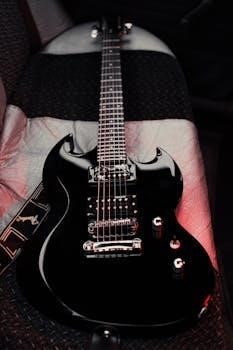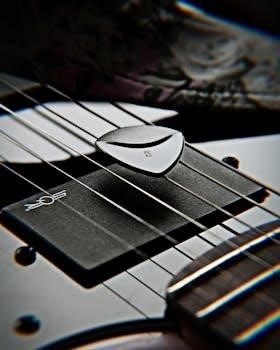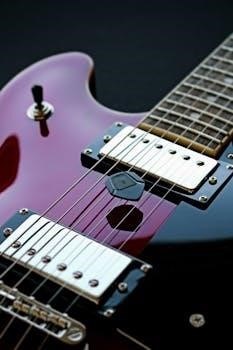guitar pickup wiring guide

Welcome to the ultimate guide for guitar pickup wiring! Whether you’re upgrading your pickups, building a custom guitar, or simply troubleshooting wiring issues, this resource provides comprehensive information. Explore various wiring diagrams, color codes, and configurations for single-coil, humbucker, and other pickup types. Learn how to achieve your desired tone!
Understanding Guitar Pickup Types
Before diving into wiring, grasping the fundamental types of guitar pickups is essential. Single-coil pickups, known for their bright and clear tone, are commonly found in Stratocasters and Telecasters. Humbuckers, featuring two coils, deliver a thicker, warmer sound and reduced noise, often used in Les Pauls and other guitars. P90 pickups offer a middle ground, with a thicker tone than single-coils but more clarity than humbuckers.
Consider the Nashville Telecaster pickups. These often blend single-coil and humbucker characteristics. HSS sets combine humbuckers and single-coils for tonal versatility. Understanding the sonic characteristics of each pickup type will guide your wiring choices and help you achieve your desired sound. Moreover, the magnetic polarity (North/South) of the coils plays a crucial role in humbucker wiring, especially when coil-splitting or considering phase relationships.
Exploring these basics is paramount before moving on to specific wiring diagrams.
Single-Coil Pickup Wiring
Single-coil pickups, renowned for their bright and articulate tones, often present simpler wiring configurations compared to their humbucker counterparts. Typically, a single-coil pickup has two wires⁚ a hot wire and a ground wire. The hot wire carries the signal from the pickup to the guitar’s electronics, while the ground wire provides a return path, reducing noise and ensuring proper function. When wiring a single-coil pickup, it’s crucial to identify these wires correctly, often distinguished by color coding.
Wiring diagrams for guitars like the Stratocaster and Telecaster showcase typical single-coil wiring schemes. These diagrams illustrate how the hot and ground wires connect to the volume pot, tone pot, and output jack. However, variations exist, especially when incorporating modifications like series/parallel wiring or custom switching options. Always consult a reliable wiring diagram specific to your desired configuration.
Furthermore, ensure proper soldering techniques and secure connections to minimize signal loss and unwanted noise. Careful attention to detail during the wiring process will result in optimal performance and tone from your single-coil pickups.
Humbucker Pickup Wiring
Humbucker pickups, designed to reduce hum and deliver a thicker tone, involve more complex wiring than single-coils. They consist of two coils wired together, either in series or parallel. Series wiring, the more common configuration, produces a higher output and a warmer, more powerful sound. Parallel wiring offers a brighter, slightly weaker signal with less hum cancellation. Understanding the wiring configuration is crucial for achieving the desired tonal characteristics.
Humbuckers typically have four wires plus a ground wire, allowing for various wiring options like coil splitting and series/parallel switching. Coil splitting deactivates one of the coils, emulating a single-coil sound, while series/parallel switching alters the way the coils are connected. These options provide versatility and expand the tonal palette of your guitar.
Wiring diagrams for humbuckers often include color codes to identify the start and end of each coil. However, these color codes can vary between manufacturers, so consulting the specific wiring diagram for your pickups is essential. Proper soldering and insulation are critical to ensure clean, noise-free operation.
Wiring Color Codes for Different Manufacturers

Navigating the world of guitar pickup wiring can be challenging, especially when dealing with different manufacturers. Each company often uses its own unique color code system, which can lead to confusion if not properly understood. These color codes indicate the function of each wire, such as the start and end of each coil in a humbucker pickup, or the hot and ground wires in a single-coil pickup.
Some common manufacturers include Seymour Duncan, DiMarzio, and Fender, each having distinct color schemes. For instance, Seymour Duncan typically uses a black wire for ground, a green wire for the hot output, and red and white wires for coil splitting. DiMarzio, on the other hand, often employs a green wire for ground, a black wire for hot, and red and white wires for series linking. Fender’s color codes can vary depending on the pickup type and era of production.
Always consult the specific wiring diagram provided by the manufacturer of your pickups to ensure correct installation. Mismatched wiring can result in incorrect phase, weak output, or even damage to the pickups or other components. Online resources and manufacturer websites are valuable sources for obtaining accurate color code information.
Basic Guitar Wiring Diagram⁚ One Volume, One Tone
The “one volume, one tone” configuration represents a fundamental circuit in electric guitars, providing essential control over the instrument’s output and tonal characteristics. This setup is favored for its simplicity and ease of modification, making it a common choice for beginners and experienced guitarists alike. The circuit consists of a volume potentiometer, a tone potentiometer, a capacitor, and the guitar’s pickup(s).
The volume potentiometer controls the overall output level of the guitar signal. By adjusting the volume knob, you can attenuate the signal from the pickup before it reaches the amplifier. The tone potentiometer, in conjunction with the capacitor, acts as a low-pass filter, allowing you to roll off high frequencies and darken the tone. The capacitor value determines the frequency range that is affected by the tone control; lower values result in a subtle effect, while higher values produce a more pronounced change.
In this basic wiring diagram, the pickup’s hot wire is connected to the volume potentiometer’s input lug, and the output lug is wired to the output jack. The tone potentiometer is connected to the volume potentiometer’s output lug, with the capacitor bridging the tone potentiometer’s input and ground. This configuration offers a straightforward and effective means of shaping your guitar’s sound.
Stratocaster Wiring Diagram⁚ 5-Way Switch
The Stratocaster, renowned for its versatility, owes much of its tonal flexibility to the 5-way switch. This switch enables players to select from a variety of pickup combinations, creating a wide spectrum of sounds. The standard Stratocaster configuration features three single-coil pickups⁚ neck, middle, and bridge. The 5-way switch allows for the following pickup selections⁚
- Neck pickup alone
- Neck and middle pickups in parallel
- Middle pickup alone
- Middle and bridge pickups in parallel
- Bridge pickup alone
Wiring a Stratocaster with a 5-way switch requires careful attention to detail. The switch has multiple lugs, each corresponding to a specific pickup or combination. The pickups are wired to the switch lugs, and the switch directs the signal from the selected pickup(s) to the volume and tone controls.

Several variations exist within the Stratocaster wiring scheme. One popular modification involves wiring the tone controls to affect different pickups. For example, one tone control might be assigned to the neck pickup, while another affects the middle and bridge pickups. Another common mod is the “blender” pot, which allows you to blend the neck pickup into any of the other switch positions, offering even more tonal possibilities.

Telecaster Wiring Diagram⁚ Standard Configuration

The Telecaster, celebrated for its bright and twangy tone, relies on a straightforward yet effective wiring configuration. The standard Telecaster setup features two single-coil pickups⁚ a neck pickup, often warmer and rounder, and a bridge pickup, known for its cutting and articulate sound. A 3-way switch provides access to the following pickup selections⁚
- Neck pickup alone
- Neck and bridge pickups in parallel
- Bridge pickup alone
In the traditional Telecaster wiring, the 3-way switch is often wired with a blend circuit in the first position (neck pickup). This means that the tone control acts as a blend knob, allowing you to mix in the bridge pickup signal with the neck pickup. However, this configuration is less common today, with most modern Telecasters using a standard tone control for all switch positions.
The wiring of a Telecaster is relatively simple compared to other guitars, making it a great project for beginners; The pickups are wired to the 3-way switch, and the switch directs the signal to the volume and tone controls. The output jack connects the signal to the amplifier.
Despite its simplicity, the Telecaster’s wiring can be modified to achieve a variety of tones. Some popular modifications include adding a series/parallel switch for the pickups, or rewiring the tone control to affect different frequency ranges.
Humbucker Wiring⁚ Coil Splitting
Humbucker pickups are renowned for their thick, powerful sound, achieved by combining two single-coil pickups wired in series. Coil splitting allows you to tap into the individual coils of a humbucker, effectively turning it into a single-coil pickup. This provides a brighter, more articulate tone, similar to a Stratocaster or Telecaster.
To achieve coil splitting, you need access to the wires connecting the two coils within the humbucker. Typically, these wires are brought out as separate leads in modern humbucker designs. The most common method involves using a push-pull potentiometer for either the volume or tone control. When the pot is in the “down” position, the humbucker functions normally. When pulled “up,” the switch shorts one of the coils to ground, effectively deactivating it and leaving only one coil active.
The specific wires that need to be connected for coil splitting depend on the humbucker’s wiring color code. Generally, you’ll need to identify the “start” and “end” wires of each coil and connect the appropriate pair to the push-pull switch. Experimentation may be required to determine which coil provides the desired single-coil tone.
Coil splitting adds versatility to a humbucker-equipped guitar, allowing you to access both thick, powerful humbucker tones and bright, articulate single-coil tones. It’s a popular modification for players seeking a wider range of sonic possibilities from their instrument.
Troubleshooting Common Wiring Issues
Guitar wiring can sometimes be a tricky endeavor, and even experienced guitarists can run into problems. Here are some common wiring issues and how to troubleshoot them⁚
No Sound⁚ The most common issue is a complete lack of sound. Check all connections, especially the ground connections. A faulty ground can kill the entire signal. Ensure the output jack is wired correctly, and that the pickup wires are securely connected to the switch or potentiometers. Use a multimeter to test for continuity in the signal path.
Weak or Distorted Sound⁚ Weak or distorted sound can indicate a faulty potentiometer or capacitor. Test the potentiometers with a multimeter to ensure they are functioning correctly. Replace any components that show signs of damage or malfunction. Also, check for cold solder joints, which can create a poor connection.
Hum or Buzz⁚ Excessive hum or buzz is often caused by grounding issues. Ensure all components are properly grounded to a common ground point, usually the back of a potentiometer or the bridge. Shielding the control cavity with copper foil can also help reduce noise.
Incorrect Pickup Selection⁚ If the pickup selector switch is not functioning correctly, double-check the wiring of the switch. Consult a wiring diagram to ensure the correct connections are made. A faulty switch may need to be replaced.
Volume or Tone Control Issues⁚ If the volume or tone controls are not working as expected, check the wiring of the potentiometers and capacitors. Ensure the correct values are used, and that the components are wired according to the diagram. A scratchy potentiometer may need cleaning or replacement.
Resources for Guitar Wiring Diagrams
Finding the right wiring diagram for your guitar project is crucial for success. Fortunately, there are numerous resources available online and in print to help you navigate the world of guitar electronics.
Online Databases⁚ Websites like StewMac, Seymour Duncan, and GuitarElectronics.com offer extensive collections of wiring diagrams for various guitar models, pickup configurations, and switching options. These databases are often searchable by guitar type (Stratocaster, Telecaster, Les Paul), pickup type (single-coil, humbucker), and desired wiring scheme (coil splitting, series/parallel).
Manufacturer Websites⁚ Many pickup manufacturers provide wiring diagrams specific to their products. Checking the manufacturer’s website can be particularly helpful when working with unique or custom pickups.
Forums and Communities⁚ Guitar forums and online communities are valuable resources for finding diagrams and getting advice from experienced guitar techs and enthusiasts. Members often share custom wiring diagrams and offer troubleshooting tips.
Books and Publications⁚ Several books on guitar electronics include detailed wiring diagrams and explanations of different wiring techniques. These books can be a great way to learn the fundamentals of guitar wiring and have a reference guide on hand.
Custom Wiring Services⁚ If you have a complex or unique wiring requirement, consider hiring a custom wiring service. These services can create a wiring diagram tailored to your specific needs.



Leave a Reply
You must be logged in to post a comment.